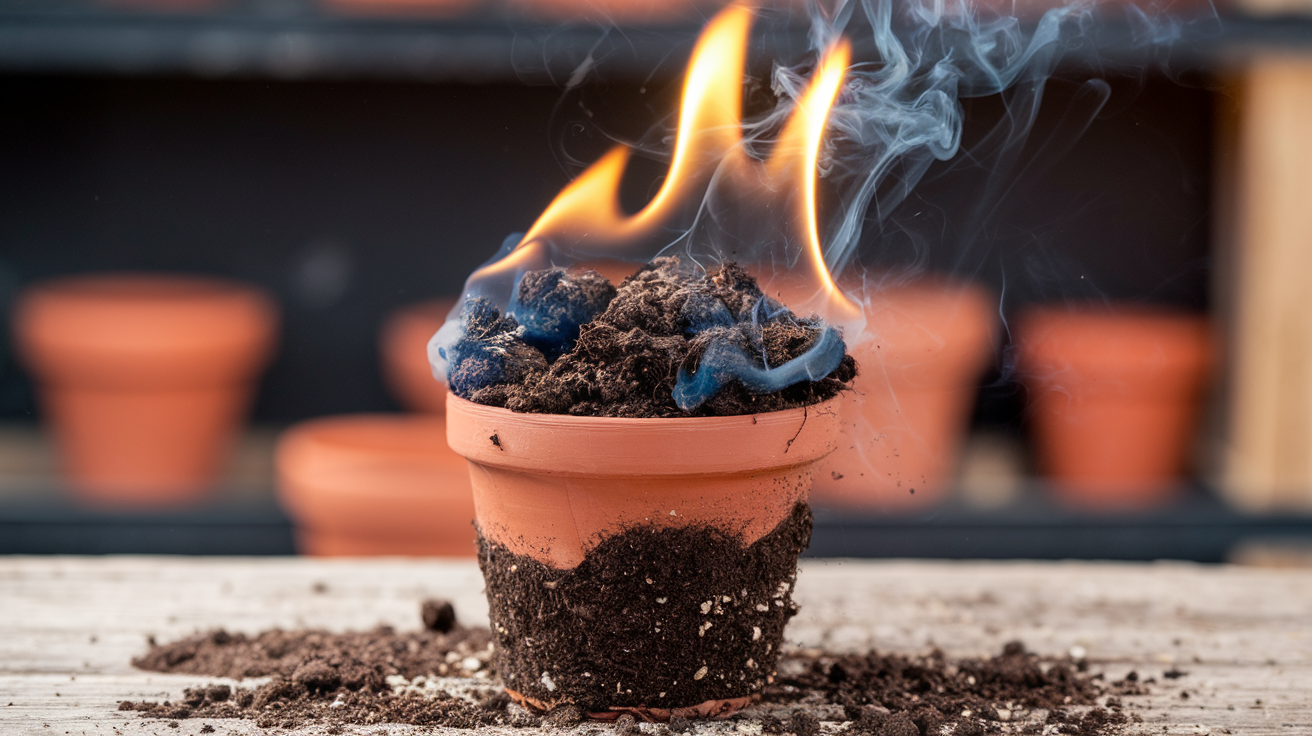Potting soil is a fundamental element in gardening, but did you know it can pose unexpected risks? As a seasoned gardener, Rhys Garden has come across various gardening challenges, but one of the most surprising is the phenomenon of spontaneous combustion in potting soil. In this article, I’ll explore the causes behind this unusual occurrence and provide essential tips on how to prevent it, ensuring your gardening experience remains safe and enjoyable.
What is Potting Soil Spontaneous Combustion?
Spontaneous combustion in potting soil might sound like something out of a science fiction novel, but it’s a real phenomenon that can occur under specific conditions. This process involves the self-heating of organic materials in potting soil, which can eventually lead to ignition without an external heat source.
To understand this process, we need to dig deeper into the composition of potting soil:
- Organic matter: Most potting soils contain a high percentage of organic materials such as peat moss, compost, or bark.
- Microorganisms: These organic components host various microorganisms, including bacteria and fungi.
- Moisture: Water is essential for plant growth and microbial activity.
- Nutrients: Potting soils often contain added fertilizers to support plant growth.
When these elements combine under the right conditions, they can create a perfect storm for spontaneous combustion.
How Does Potting Soil Spontaneous Combustion Occur?

The process of spontaneous combustion in potting soil is a fascinating interplay of biology and chemistry. Let’s break it down step by step:
- Microbial activity: The microorganisms in the soil begin to break down the organic matter.
- Heat generation: This decomposition process generates heat as a byproduct.
- Insulation: The potting soil acts as an insulator, trapping the heat within.
- Temperature rise: As the heat builds up, the temperature of the soil increases.
- Accelerated decomposition: Higher temperatures lead to more rapid decomposition, creating a feedback loop.
- Ignition point: If the temperature reaches the ignition point of the materials present, combustion can occur.
It’s important to note that this process typically requires a large volume of potting soil and specific environmental conditions to occur.
Factors Contributing to Potting Soil Spontaneous Combustion
Several factors can increase the likelihood of spontaneous combustion in potting soil:
Moisture Content
While it might seem counterintuitive, moisture plays a crucial role in this process. A moderate amount of moisture (30-40%) can actually increase the risk of spontaneous combustion. This is because water facilitates microbial activity and heat transfer within the soil.
Pile Size
Larger piles of potting soil are more susceptible to spontaneous combustion. This is because they have a higher ratio of volume to surface area, which means heat can build up more easily in the center of the pile without dissipating.
Environmental Temperature
Higher ambient temperatures can accelerate the process of spontaneous combustion. This is why incidents are more common during hot summer months.
Composition of the Potting Soil
Soils with a higher percentage of organic matter are more prone to spontaneous combustion. Peat-based potting soils, in particular, have been associated with this phenomenon.
Presence of Fertilizers
Some fertilizers, especially those containing nitrogen, can increase the risk of spontaneous combustion by accelerating microbial activity and heat generation.
Real-Life Incidents of Potting Soil Spontaneous Combustion
To underscore the reality of this phenomenon, let’s look at some documented cases:
- In 2020, a house fire in Chalford, UK, was attributed to the spontaneous combustion of peat-based compost stored in the homeowner’s garage.
- The Queensland Fire and Emergency Services in Australia reported multiple incidents of potting mix spontaneously combusting in 2019, leading to house fires.
- In 2017, a significant fire at a garden center in Oakville, Ontario, Canada, was traced back to the spontaneous combustion of bulk potting soil.
These incidents highlight the importance of proper storage and handling of potting soil, especially in large quantities.
How to Prevent Potting Soil Spontaneous Combustion
As responsible gardeners, it’s crucial to take steps to minimize the risk of spontaneous combustion in our potting soil. Here are some practical tips:
Proper Storage
Store potting soil in a cool, dry place away from direct sunlight. If storing large quantities, consider breaking them down into smaller piles to allow for better heat dissipation.
Moisture Management
While potting soil needs to be moist for plant health, avoid over-watering. Allow the soil to dry out between waterings, especially in storage.
Regular Checks
Periodically check stored potting soil for signs of heating. If you notice steam rising from the pile or it feels unusually warm to touch, spread it out to cool down.
Use of Containers
When possible, store potting soil in containers rather than in large, open piles. This can help limit oxygen access and reduce the risk of combustion.
Avoid Mixing with Flammable Materials
Keep potting soil separate from other potentially flammable materials like dry leaves, paper, or cardboard.
The Role of Potting Soil in Container Gardening
While we’ve focused on the potential risks, it’s important to remember that potting soil plays a crucial role in successful container gardening. Let’s explore why it’s so important and how to use it safely:
Benefits of Quality Potting Soil
- Nutrient-rich: Good potting soil provides essential nutrients for plant growth.
- Well-draining: It allows excess water to drain while retaining enough moisture for plant roots.
- Aeration: Quality potting soil provides air pockets for root respiration.
- pH balanced: It’s usually formulated to have an optimal pH for most plants.
Safe Use of Potting Soil in Containers
- Choose the right soil: Select a potting mix appropriate for your specific plants.
- Use clean containers: Ensure your pots are clean and have drainage holes.
- Avoid overfilling: Leave some space at the top of the container for watering.
- Monitor moisture: Water when the top inch of soil feels dry, but avoid waterlogging.
- Refresh annually: Replace or refresh potting soil in containers every year to maintain nutrient levels and structure.
Alternatives to Traditional Potting Soil
For those concerned about the risks associated with traditional potting soil, there are alternatives:
Coconut Coir
Made from coconut husks, coir is renewable and less prone to spontaneous combustion. It has excellent water retention properties.
Perlite and Vermiculite Mixes
These inorganic materials can be mixed with organic components to create a well-draining, less combustible potting mix.
Synthetic Growing Media
Some hydroponic growing media, like rockwool or expanded clay pellets, can be used for container gardening with minimal risk of combustion.
DIY Potting Mixes
By creating your own mix, you can control the components and potentially reduce the risk of spontaneous combustion. A basic recipe might include:
- 1 part compost
- 1 part perlite
- 1 part vermiculite
- 1 part topsoil
The Impact of Potting Soil Combustion on Plant Health
While our primary concern with potting soil combustion is safety, it’s worth considering how this phenomenon might affect plant health:
Root Damage
If soil temperatures rise significantly, even without reaching the point of combustion, it can damage plant roots.
Nutrient Changes
The heating process can alter the chemical composition of the soil, potentially affecting nutrient availability.
Microbial Population Shifts
Extreme temperatures can kill beneficial microorganisms in the soil, disrupting the soil ecosystem.
pH Alterations
The combustion process can change the pH of the soil, which may impact nutrient uptake by plants.
Environmental Considerations
As environmentally conscious gardeners, we should also consider the broader implications of potting soil spontaneous combustion:
Air Quality
When potting soil combusts, it can release various gases and particulates into the air, potentially contributing to air pollution.
Fire Risk
Beyond the immediate danger to property, fires started by potting soil combustion can spread to natural areas, posing a risk to ecosystems.
Resource Waste
When potting soil is lost to combustion, it represents a waste of resources, including the energy and materials used in its production.
Carbon Release
The combustion process releases stored carbon from organic materials back into the atmosphere, contributing (albeit on a small scale) to greenhouse gas emissions.
Innovative Solutions in Potting Soil Technology
The gardening industry is continually evolving, and researchers are working on innovative solutions to make potting soils safer and more effective:
Fire-Resistant Additives
Some companies are exploring the use of fire-resistant additives that can be mixed into potting soil to reduce the risk of combustion.
Smart Sensors
New technology is being developed to monitor temperature and moisture levels in large quantities of stored potting soil, alerting gardeners to potential risks.
Biochar Integration
Incorporating biochar into potting mixes may help reduce the risk of spontaneous combustion while improving soil structure and nutrient retention.
Microbial Engineering
Research is being conducted on selecting and cultivating specific microbial populations that can break down organic matter efficiently without generating excessive heat.
The Future of Safe Gardening Practices
As we look to the future, it’s clear that the gardening community needs to stay informed and adaptable. Here are some trends and considerations for the future of safe gardening practices:
Education and Awareness
Increasing awareness about the potential risks associated with potting soil and other gardening materials will be crucial. Gardening clubs, nurseries, and online platforms can play a significant role in disseminating this information.
Regulatory Changes
We may see changes in regulations governing the composition and labeling of potting soils, particularly for commercial and large-scale use.
Sustainable Alternatives
As sustainability becomes increasingly important, we’re likely to see more eco-friendly alternatives to traditional peat-based potting soils gaining popularity.
Technology Integration
The integration of technology into gardening practices, such as moisture sensors and smart irrigation systems, may help mitigate risks associated with potting soil management.
Climate Adaptation
As climate change affects temperatures and weather patterns, gardeners may need to adapt their practices, including how they store and use potting soil.
Conclusion
Understanding the potential for spontaneous combustion in potting soil is crucial for every gardener. By being aware of the risks and taking preventive measures, you can continue to enjoy gardening without worry. Proper storage and handling of potting soil not only safeguard your garden but also protect your home and surroundings. Stay informed and garden safely to keep your passion for plants thriving.

Related Posts
Best Soil for Indoor Plants: A Guide for Thriving Greenery
The Ultimate Guide to Sand Soil Mix for Leveling
Topsoil vs Fill Dirt: Choosing the Right Soil for Your Garden